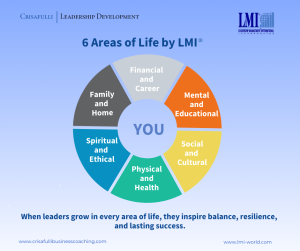
Why Balanced Leaders Perform Better: The Six Areas of Life by LMI
08/21/2025
by
Jim Crisafulli

In leadership and in life, success is rarely one-dimensional. A person may achieve great financial results yet feel unfulfilled at home, or build a thriving career but neglect their health. True success, as taught in Leadership Management International’s Total Person® Concept, means living a balanced life.
This is where the Six Areas of Life come in—a framework for personal and professional growth that ensures leaders don’t just achieve more, but also live with greater purpose and fulfillment.

1. Family & Home: The Foundation of Support
Leadership begins at home. The way we nurture relationships with family and loved ones directly impacts our emotional well-being and stability. A leader who feels supported at home is more confident, less stressed, and better able to give their best at work.
- Practical Examples:
- Scheduling family time with the same priority as business meetings.
- Practicing open communication with loved ones to strengthen trust.
- Creating family traditions that build lasting bonds.
When leaders build a strong foundation at home, they carry that sense of belonging and security into the workplace. A fulfilled personal life fuels resilience and makes leaders more empathetic, understanding, and inspiring to others.

2. Financial & Career: Building Security and Growth
Money isn’t everything, but financial stress can undermine every other part of life. Leaders who plan their financial future wisely are able to focus on growth and contribution, instead of worrying about stability.
- Practical Examples:
- Setting clear career milestones and working toward continuous progress.
- Practicing financial discipline: budgeting, saving, and investing.
- Using career success as a platform to contribute to others (mentoring, philanthropy, or knowledge sharing).
Leaders who are financially confident can make bold, strategic decisions without fear. They become role models in responsibility and foresight, encouraging their teams to plan for both short-term wins and long-term goals.

3. Mental & Educational: Lifelong Learning
The most effective leaders are also the most curious. They don’t settle with what they already know; instead, they constantly seek opportunities to learn, adapt, and grow. In a fast-changing world, mental agility is one of the greatest leadership assets.
- Practical Examples:
- Reading leadership, business, or personal development books regularly.
- Attending seminars, webinars, or advanced training sessions.
- Seeking mentors who challenge and expand their perspectives.
- Developing critical thinking and problem-solving skills.
Leaders who invest in their mental and educational growth remain relevant, innovative, and adaptable. They inspire a culture of learning in their organizations, where continuous improvement becomes the standard.

4. Physical & Health: Energy for Leadership
Leadership requires stamina, focus, and resilience—qualities that are impossible to maintain without good health. A leader’s physical condition doesn’t just affect them personally; it impacts the energy they bring to their teams.
- Practical Examples:
- Maintaining a regular exercise routine to boost energy and reduce stress.
- Prioritizing adequate rest and sleep to improve decision-making.
- Practicing mindful eating habits for sustained energy throughout the day.
- Incorporating stress-management techniques such as meditation, breathing exercises, or outdoor activities.
Healthy leaders lead by example. Their vitality and energy create a ripple effect in the workplace, encouraging others to adopt healthier, more productive lifestyles.

5. Spiritual & Ethical: Anchored in Values
At the core of true leadership is integrity. The spiritual and ethical dimension grounds leaders in values, principles, and a sense of higher purpose. This inner compass guides decision-making, especially in challenging times.
- Practical Examples:
- Taking time for daily reflection, prayer, or meditation.
- Defining personal values and aligning decisions with them.
- Demonstrating honesty and fairness, even when it’s difficult.
- Living with humility and recognizing leadership as service, not just authority.
- Why it matters: Leaders who are anchored in strong values earn trust and respect from their teams. Their decisions carry weight not only because of their position, but because people believe in their integrity. This creates long-term influence and loyalty.

6. Social & Cultural: Connecting Beyond Yourself
No leader thrives in isolation. The social and cultural dimension expands leadership beyond the workplace, encouraging leaders to contribute to their communities and build meaningful connections with others.
- Practical Examples:
- Building strong professional networks and friendships.
- Engaging in volunteer work or community projects.
- Exploring new cultures through travel, books, or events.
- Encouraging inclusion and diversity within the workplace.
Leaders who are socially and culturally aware bring empathy, open-mindedness, and collaboration into their organizations. By engaging with diverse perspectives, they build inclusive environments where innovation and cooperation thrive.
The Power of Balance in Leadership
The Six Areas of Life remind us that leadership is not just about performance metrics—it’s about balance, growth, and purpose. Neglecting one area eventually affects the others: poor health drains productivity, financial stress affects focus, and lack of family connection can erode motivation.
By setting SMART goals in all six areas, leaders create harmony that makes them more effective, resilient, and fulfilled.
The Total Leader® program of LMI builds on this Total Person® Concept, helping individuals develop across all areas of life. Because when leaders grow as whole people—not just professionals—they don’t just achieve success; they inspire it in others.
👉 Ask yourself: Which of the six areas needs more attention in your life today?
Written By
Jim Crisafulli